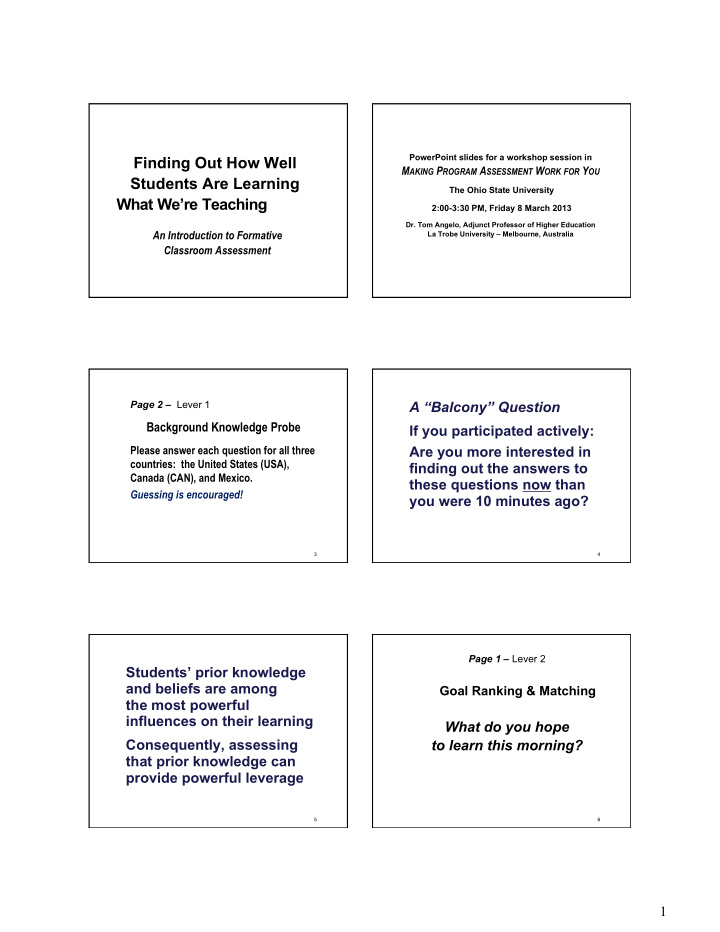



PowerPoint slides for a workshop session in Finding Out How Well M AKING P ROGRAM A SSESSMENT W ORK FOR Y OU Students Are Learning The Ohio State University What We’re Teaching 2:00-3:30 PM, Friday 8 March 2013 Dr. Tom Angelo, Adjunct Professor of Higher Education An Introduction to Formative La Trobe University – Melbourne, Australia Classroom Assessment Page 2 – Lever 1 A “Balcony” Question Background Knowledge Probe If you participated actively: Please answer each question for all three Are you more interested in countries: the United States (USA), finding out the answers to Canada (CAN), and Mexico. these questions now than Guessing is encouraged! you were 10 minutes ago? 3 4 Page 1 – Lever 2 Students’ prior knowledge and beliefs are among Goal Ranking & Matching the most powerful influences on their learning What do you hope to learn this morning? Consequently, assessing that prior knowledge can provide powerful leverage 5 6 1
The Usefulness of Shared Goals Teaching Objectives for this Session Without shared goals, we are less likely to collaborate willingly and effectively. 1. Propose seven research-based guidelines to improve teaching and learning What are your learning goals today? 2. Demonstrate applications of those guidelines 3. Provide hands-on experience with those applications What are your colleagues’ goals? 4. Encourage you to identify possible applications to How much common ground—in terms of your own teaching and your students’ learning shared goals—can you find? Tom Angelo -- thomas.a.angelo@gmail.com 8 7 Intended Learning Outcomes 2nd “Balcony” Question for this Session If you participated actively: By the end of this brief workshop, participants will have: 1. Evaluated the relevance to their own teaching practice of seven What differences do you (7) research-based guidelines proposed in the workshop note between “teaching 2. Evaluated the potential usefulness of at least five (5) new strategies/techniques practiced during the workshop objectives” and “intended 3. Committed to adapt and apply at least two or three (2-3) learning outcomes”? strategies/techniques to improve their students’ learning (Are they consequential 4. Identified at least two (2) useful resources and references differences?) for follow up Tom Angelo -- thomas.a.angelo@gmail.com 9 Tom Angelo -- thomas.a.angelo@gmail.com 10 Page 3 – Lever 6 “It’s not what we do, Collaborative Learning Technique but what students do Think-Pair-Share that’s the important This is a “Low-Threshold Application” • Low complexity – easy to use thing.” • Low cost – in time and effort • Low risk – to teachers or learners Biggs, J. & Tang, C. (2007). Teaching for • Relatively high ROI (Return on Investment) Quality Learning at University, 3 rd Edition. Berkshire: McGraw-Hill, p. 19. • Potentially worth adapting? 12 2
Page 13 – Lever 5 Page 4 – Lever 1 Another “Low-Threshold Application” Background Knowledge Probe Applications Card A simple, quick way to assess Ideas/Techniques Possible Applications students’ prior knowledge before we begin teaching – to better fit teaching to learning and to provide feedback to students. 13 14 Page 5 – Lever 1 Three Preconditions for Deep Learning Concept Tests • Shared TRUST • Shared LANGUAGE & CONCEPTS • Shared GOALS 15 16 Page 6 – Lever 3 Page 7 – Lever 4 Two Simple Metacognitive “Levers” Group Informal Feedback on Teaching is the The Minute Paper G.I.F.T. and The Muddiest Point 17 18 3
Page 13 Page 8 – Lever4 Applications Card Discussion Draft Questions Course/Teaching Feedback Form for an Undergraduate Ideas/Techniques Possible Applications 19 20 Page 12 A “Balcony” Question Seven Levers for Deeper Learning � � Please mark each of the 7 “levers” with If you followed directions: a plus sign, minus sign, or question mark Did you read and think • Use the plus ( + ) if you understand and agree about the list on page 8 • Use the minus ( – ) if you understand, any differently than you but disagree would have if you had • Use the question mark (?) if the lever’s simply been asked to meaning is unclear – or if you’re unsure “read it”? 21 22 Page 13 – Guidelines #1 & #3 A Two-Sentence Summary of this morning’s workshop The Minute Paper and The Muddiest Point It’s what the learners do that matters most to their learning. But teachers can greatly and positively influence what learners do and learn. 23 24 4
Assessment & Feedback Page 15 for Learning: � � Why Give Learners Feedback? � � A Gap-Analysis Approach � � How Can We Make it More Find the Gaps Consequential and Useful? Mind the Gaps Close the Gaps 25 26 Page 13 – Lever 5 Page 19 – Lever 5 Applications Card Applications Card Ideas/Techniques Possible Applications Choose one of your possible applications. Prepare to answer the three questions below about that specific application: • What is it? • Why do you think it might be useful? • How do you think you might use it? 27 28 Page 9 – Seven Levers for Deeper Learning • Prior knowledge and beliefs • High expectations and clear goals • Metacognition – Learning tools • Standards, assessment and feedback • Connections – Transfer and application • Collaboration toward shared goals • Time invested in engaged, active learning 29 30 5
Please complete the workshop evaluation. Feel free to send further questions, comments, critiques and suggestions to thomas.a.angelo@gmail.com 6
Recommend
More recommend